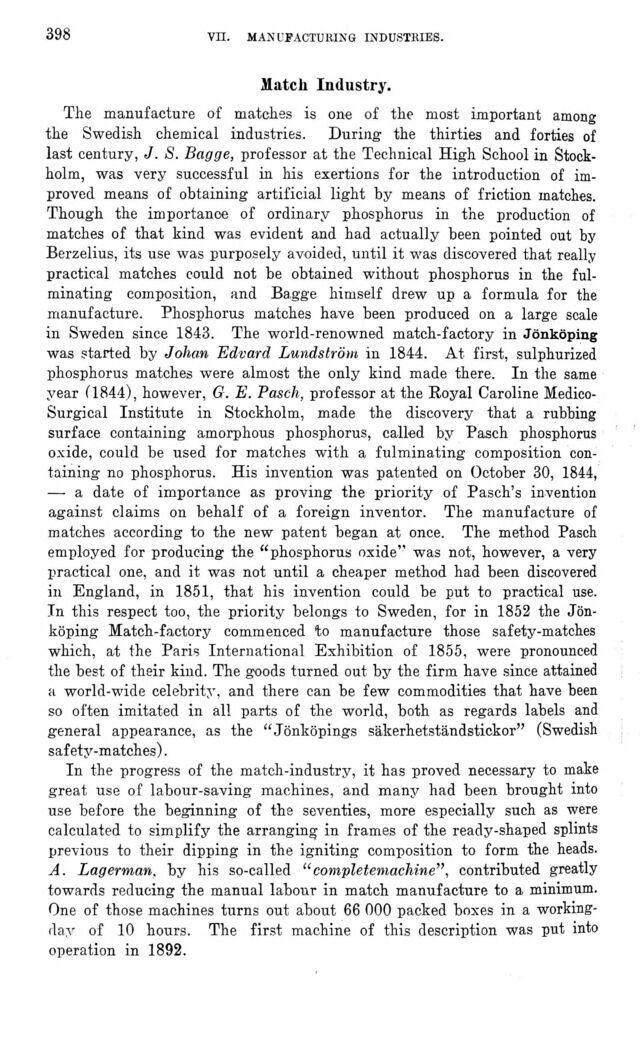
Full resolution (JPEG) - On this page / på denna sida - VII. Manufacturing Industries. Introd. by [G. Sundbärg] K. Åmark - 5. Timber-Ware Industry - Match Industry. By Alf. Larson

<< prev. page << föreg. sida << >> nästa sida >> next page >>
Below is the raw OCR text
from the above scanned image.
Do you see an error? Proofread the page now!
Här nedan syns maskintolkade texten från faksimilbilden ovan.
Ser du något fel? Korrekturläs sidan nu!
This page has never been proofread. / Denna sida har aldrig korrekturlästs.
398
vii. manufacturing industries.
Match Industry.
The manufacture of matches is one of the most important among
the Swedish chemical industries. During the thirties and forties of
last century, J. S. Bagge, professor at the Technical High School in
Stockholm, was very successful in his exertions for the introduction of
improved means of obtaining artificial light by means of friction matches.
Though the importance of ordinary phosphorus in the production of
matches of that kind was evident and had actually been pointed out by
Berzelius, its use was purposely avoided, until it was discovered that really
practical matches could not be obtained without phosphorus in the
fulminating composition, and Bagge himself drew up a formula for the
manufacture. Phosphorus matches have been produced on a large scale
in Sweden since 1843. The world-renowned match-factory in Jönköping
was started by Johan Edvard Lundström in 1844. At first, sulphurized
phosphorus matches were almost the only kind made there. In the same
year C1844), however, G. E. Pasch, professor at the Royal Caroline
Medico-Surgical Institute in Stockholm, made the discovery that a rubbing
surface containing amorphous phosphorus, called by Pasch phosphorus
oxide, could be used for matches with a fulminating composition
containing no phosphorus. His invention was patented on October 30, 1844,
—- a date of importance as proving the priority of Pasch’s invention
against claims on behalf of a foreign inventor. The manufacture of
matches according to the new patent began at once. The method Pasch
employed for producing the "phosphorus oxide" was not, however, a very
practical one, and it was not until a cheaper method had been discovered
in England, in 1851, that his invention could be put to practical use.
In this respect too, the priority belongs to Sweden, for in 1852 the
Jönköping Match-factory commenced to manufacture those safety-matches
which, at the Paris International Exhibition of 1855, were pronounced
the best of their kind. The goods turned out by the firm have since attained
a world-wide celebrity, and there can be few commodities that have been
so often imitated in all parts of the world, both as regards labels and
general appearance, as the "Jönköpings säkerhetständstickor" (Swedish
safety-matches).
In the progress of the match-industry, it has proved necessary to make
great use of labour-saving machines, and many had been brought into
use before the beginning of the seventies, more especially such as were
calculated to simplify the arranging in frames of the ready-shaped splints
previous to their dipping in the igniting composition to form the heads.
A. Lagerman. by his so-called "completemachine", contributed greatly
towards reducing the manual labour in match manufacture to a minimum.
One of those machines turns out about 66 000 packed boxes in a
working-day of 10 hours. The first machine of this description was put into
operation in 1892.
<< prev. page << föreg. sida << >> nästa sida >> next page >>